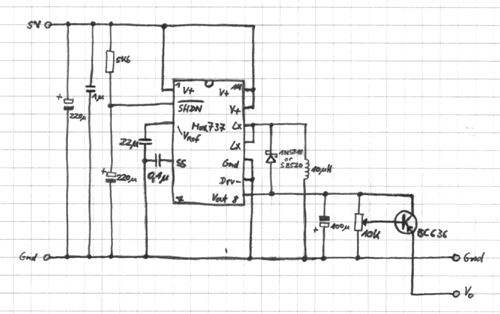
size of image in full size: 324k
As display I use a Varitronix MGLS-24064-HT-FSTN with a white LED backlight. It is a graphics display with 240*64 pixels and a T6963 LCD controller which can easily be hooked up to the parallel port.
Unfortunately it needs a rather high contrast voltage due to its high temperature range: it may be as high as -23V, but I found out that even at -15V the display is entirely black so a contrast voltage in the range of -13.8 to -14.2V is optimal. To convert the +5V to -15V I use the MAX737 from maxim which is an inductor-based inverting switch-mode regulator:
Just in case you wonder what the function of the RC combination (connected to the /SHDN pin) is: it delays the power up of the contrast voltage for a short period of time so that the display controller can initialize and the display doesn't take any damages. If you're interested in the backgrounds you can read this document.
Here is the schematic that shows how the display is hooked up to the parallel port:
The RC combination is used to reset the display controller on startup.
By connecting pin 19 of the display connector to VDD I have set the font size to 6x8 which is a better choice over the 8x8 font you would choose by connecting the pin to ground. It enables the display to have 40 characters per row instead of 30 at 8x8 (and imo looks better). For the control program it's no big difference if you use the 6x8 or 8x8 font because it generates the font internally and doesn't use the display's character generator. The only thing you have to be aware of is that you have to change the number of pixels that have place in one byte of the display's RAM. The Tdisplay.updateDisplay routine takes x pixels, packs them into one byte and transfers it into the RAM - if the font is 6x8 it has to pack 6 pixels into one byte, otherways it has to take 8 pixels.
Perhaps the most important reason why I love this display so much is that it's really fast. I optimized the display output routines quite a lot and I now have a frame rate of approx. 10 fps which allows me to show animations as well as still images. Combined with some 3D math it's quite astonishing how cool the yume logo can look on the display :-)